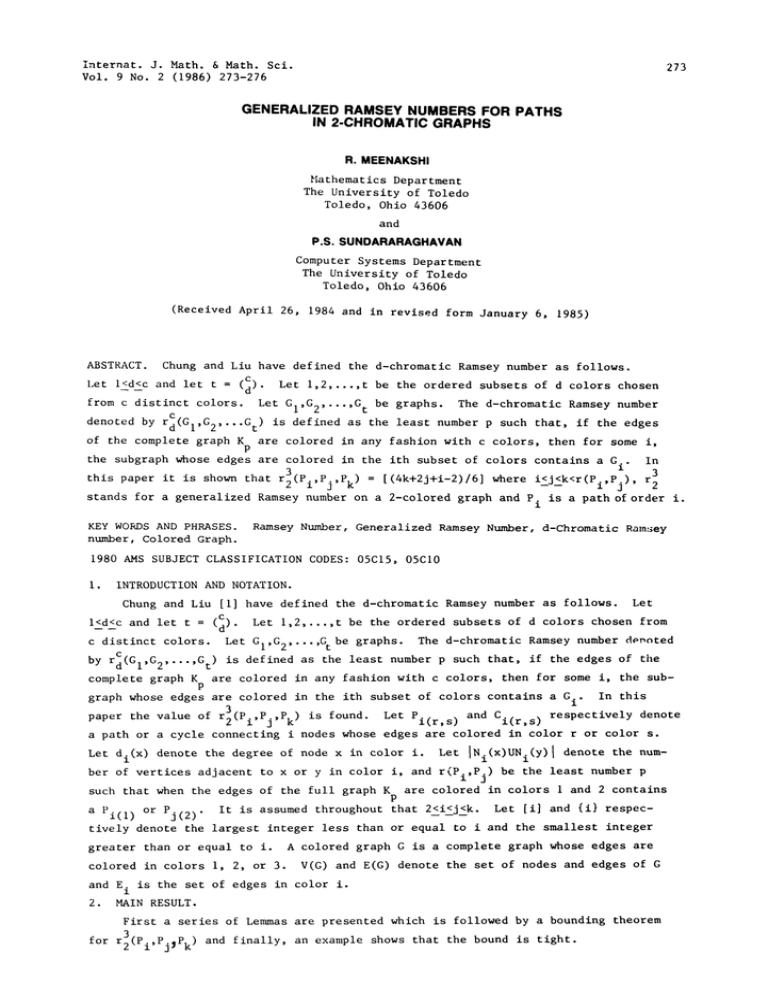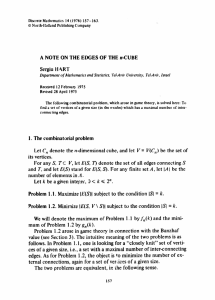Document 10507970
advertisement

Internat. J. Math. & Math. Sci.
Vol. 9 No. 2 (1986) 273-276
273
GENERALIZED RAMSEY NUMBERS FOR PATHS
IN 2-CHROMATIC GRAPHS
R. MEENAKSHI
Mathematics Department
The University of Toledo
Toledo, Ohio 43606
and
P.S. SUNOARARAGHAVAN
Computer Systems Department
The University of Toledo
Toledo, Ohio 43606
(Received April 26, 1984 and in revised form January 6, 1985)
ABSTRACT.
Chung and Liu have defined the d-chromatic Ramsey number as follows.
().
Let l<d<c and let t
Let 1,2
t be the ordered subsets of d colors chosen
from c distinct colors. Let GI,G2,...,G be graphs. The d-chromatic Ramsey number
t
c
rd(Gi,G 2 G is defined as the least number p such that, if the edges
of the complete graph K are colored in any fashion with c colors, then for some i,
P
the subgraph whose edges are colored in the ith subset of colors contains a G.. In
l
3
3
this paper it is shown that
[(4k+2j+i-2)/6] where
r
2
stands for a generalized Ramsey number on a 2-colored graph and P. is a path of order i.
t)
denoted by
r2(Pi,Pj,Fk)
i<_j<_k<r(Pi,Pj)
l
KEY WORDS AND PHRASES.
number, Colored Graph.
Ramsey Number, Generalized Ramsey Number, d-Chromatic Ramsey
1980 AMS SUBJECT CLASSIFICATION CODES: 05C15, 05CI0
I.
INTRODUCTION AND NOTATION.
Chung and Liu [I] have defined the d-chromatic Ramsey number as follows.
().
l<d<c and let t
c distinct colors.
r(GI,G
by
G
2_
t)
Let 1,2
Let
t be the ordered subsets of d colors chosen from
graphs. The d-chromatic Ramsey number de-oted
2,
is defined as the least number p such that, if the edges of the
Let
GI,G
Gtbe
are colored in any fashion with c colors, then for some i, the subP
graph whose edges are colored in the ith subset of colors contains a G i. In this
respectively denote
is found. Let
paper the value of
Pi(r,s) and
complete graph K
r(Pi,Pj,Pk)_
Ci(r,s)
a path or a cycle connecting i nodes whose edges are colored in color r or color s.
Let
di(x)
denote the degree of node x in color i.
ber of vertices adjacent to x or y in color i, and
such that when the edges of the full graph K
a
Pi(1)
or P
j(2)"
P
Let
INi(x)UNi(Y)
r(Pi,P j)
are colored in colors
It is assumed throughout that 2<i<j<k.
denote the num-
be the least number p
and 2 contains
Let [i] and {i} respec-
tively denote the largest integer less than or equal to i and the smallest integer
greater than or equal to i. A colored graph G is a complete graph whose edges are
colored in colors I, 2, or 3.
V(G) and E(G) denote the set of nodes and edges of G
and E. is the set of edges in color i.
1
2.
MAIN RESULT.
First a series of Lemmas are presented which is followed by a bounding theorem
for
r3(Pi,PjPk)z
and finally, an example shows that the bound is tight.
274
R. MEENAKSHI and P. S. SUNDARARAGHAVAN
Lemma
3
r(P
r2(Pi ,pj ’Pk
i
when i<3
,Pj)
(2.1)
It is well known that
Proof:
j+[i/2] when j>i>2.
r(Pi,P j)
(2.2)
In [I] it is shown that
3
r2(Gi,Oj,Gk)<_r(Gi,Gj),
and the equality holds if
for i<j<k,
(2.3)
k>r(Gi,Gj).
Lemma 2
3
r2(P i ,Pj Pk)<[(4k+2j+i-2)/6]
when i=4 and
(2.4)
k<r(Pi,Pj).
Proof- From (2.2)and (2.3), k=j and [(4k+2j+i-2)/6]=j+[(i-2)/6].
Let j=4 and G be a
colored K
xeV(G)-
If y
4nd
with no
4
as a subgraph which implies that 3 a
P4(1,2)
z are adjacent to x is color 3 then G has a
3
r2(P4,Pj_I,Pj_ 1)
Let G be a colored
with no
Kj
by (2.5)G-x contains a
or
P[j-I](I,3)
If
as a subgraph.
P4(1,2)
Hence, let d(x) _> 3
(l, z)
Pj(2,3)"
for all j>4.
j-I
P[j-I](2,3)
or
P4(1,3)
-
P4(2,3)"
d3(x)_>2.
Assume that
(2.5)
a xeV(G)-
and so G contains a
d3(x)>j-3_
then
or
Pj(I,3)
P4(1,2)’
xeN(G), which implies that G contains a
a contradiction.
Lemma 3:
r
Proof:
k-2[(k+4)/6].
Let k>3 and
3
2(pj ,Pj ,Pk
Then
<_k-l.
Let s be the least non-negative integer -)
k(mod 6).
s
It is easily shown that
K-l-[s/2].
j+[j/2]-I
r(Pj,Pj)
(2.6)
From (2.3) and (2.6) the lemma follows.
Lemma 4:
Let
k>_3
k+[(k-2)/6].
and
C[k_l](l,2), C[k_l](l,3),
Pk(2,3)’ respectively.
or
Let G be a colored
C[k_i](2,3),
then G contains a
Proof:
Without loss of generality assume that G contains a
Pk(2,3)
which implies that the
adjacent in color
contains a
assume that
Pj(I,2)
Pj(I,2)
to
or
Ck_ I.
Pj(I,3)
[(k+4)/6]
in
Ck_ I,
If G contains a
Pk(l,2)’ Pk(l,3)’
where j
C[k_i](2,3) but not
C[k_i](2,3) are
k-2[(k+4)/6].
but adjacent to every vertex of
vertices in color
I,
Since there exists
Ck_
in color
vertex disjoint from
Ck_
Without loss of generality
is present and let x be one of its end vertices.
Ck_ I.
or
vertices of G not in
By Lemma 3, the subgraph generated by nodes of
remaining 2[(k+4)/6]-i vertices of
2[(k+4)/6]
K.
[(k+4)/6]
Consider the
vertices not
I, there exists a path P with
Pj(I,2)
referred above.
GE;ERALIZED RAMSEY
NUMBERS FOR PATHS IN 2-CHROMATIC GRAPHS
This path P has an end vertex adjacent to x in color
275
and hence G contains P
k(1,2)
as a subgraph.
Theorem I:
3
<
r2(Pi,Pj,Pk)
k<j+[i/2]-I
when
Proof:
(2.7)
r(Pi,Pj).
If i<4, the theorem follows from Lemma 2.
into three main cases.
i>5.
[(4k+2j+i-2)/6]
Case I:
Assume that the theorem holds when i’<i,j’<j or k’<k where
[(4k+2j+i-2)/6].
Define
Let i
k.
d
n
The rest of the proof is divided
Let G be a colored
KE.
Without loss of generality let
xleV(G
be -)
l(x l)>d i(x)
(2.8)
2,3 and xV(G) and 2 < n.
For i
Consider G-x
By the induction hypothesis,
I.
3
r2 (el_2, Pi_2, Pi)<i-2+[ (i+4)/6]
which implies that G-x
contains a
Without loss of generality assume that G-x
P
has P
Pi(2,3)"
and denote this path by
[i-2] (1,2)
z).
(y
Case I.I:
and (x
Let (x l,y)eE
Lemma 4.
If
(Xl,U)eE-E(P)
and
l,z)eE 3,
(Xl,U)eE
since otherwise the proof follows from
Let (y,u)E
adjacent to v in P on the segment from v to y.
(xl,y
V,Xl),
u,z
Pi(l,2)" Thus X is adjacent
(Xl,V)eE and veV(P). Let u be
then G has a
Let v # y be -)
V(P) in color I.
to n vertices of
cycle
or
P[i-2](1,2)’ P[i-2](1,3)
3.
Then the existence of
by Lemma 4 implies the existence of
Pi(l,2)
completing
the proof.
Suppose we let (z,u)eE
hence let (z,f)eE
d3(z)<_n,
Since
Let
Case 1.2:
and n
2
3
for all f.
[(i+4)/6]
(xl,Y)
vertices of
(Xl,V)eE 1.
Let fe V(G)-V(P).
3.
Since
If
then G has a
(z,f)eEiUE 2,
V(G)-V(P)
[(i+4)/6]+1,
Pi(l,2) and
d3(z)>[(i+4)/6]+l+n-l.
0 contradicting i>5.
(Xl,Z)
and
be in E
V(G)-V(P) in color
3.
Let x
where
nl,n2>_O.
Let vU(P) be such that
,v).
Let u be a vertex adjacent to v on the segment (y
similar to that used in Case ioi, it can be shown that if
For weV(G)-V(P) if (x,w)eE
in color 3.
is adjacent to at least n
2
vertices of
and
(z,w)eEiUE 2
V(G)-V(P)
By an argument
(z,u)E 3 the proof follows
For the other case, let z be adjacent to at least n
from Lemma 3.
vertices of V(P)
be adjacent to n
vertices of V(P)
the theorem follows.
in color 3.
So
So z
d3(z)>_nl+n2+l,
contradicting (2.8).
Case 2:
Let i
r2(Pi_2,3 Pi-2’Pk
j < k.
If x
< E-I and Case
is
-)
dl(Xl)
applies.
>
di(x
for i
1,2,3 and xeV(G) then
Hence, without loss of generality assume
1,2,3 and xeV(G).
Consider G-x
d2(x2) di(x)
2. By induction hypothesis
< E-I and hence G-x contains
r2(Pi_ ’ej’Pk-l)
P[i-2](1,2)’ Pj(I,3) or P[k-l](2,3)"
2
is present the proof is similar to Case I. Let G-x contain
If
2
P[i-2](1,2)
z is an end vertex of this path then by arguments similar to Case
If
P[k-l](2,3)"
that
23
>
for i
R. MEENAKSHI and P. S. SUNDARARAGHAVAN
276
d1(z) d2(x 2) is derived thus
Pj(I,3) is a subgraph of G-x 2.
a contradiction,
again follows if
Let i <
Case 3:
for yeV(G).
< k <
j+[i/2]-l.
By induction hypothesis
or
P[j-I](I,3)
dl(X)+d2(x)
Let xeV(G) be such that
3
r2(Pi,Pj_l,Pk_l)
<
The theorem
d&(x)+d2(x
<
E-I, G-x contains a
dl(Y)+d2(Y
Pi(l,2)’
The case is not obvious, if one of the latter two paths
P[k-l](2,3)"
If
is present.
proving the theorem.
<
[j/2], then
d3(x
>
{k/2} so that x is adjacent to more
than half the vertices of the graph and hence of the path under consideratioin
color 3.
<EIUE2
Therefore, G contains a
Pj(I,3)
or
and hence G has a
Pi(l,2).
However, if
<EIUE2 >
two components, each of which is of order
{j/2} and if
PE(I,2)’ > 2{j/2}
dl(X)+d2(x)
If
Pk(2,3)"
> is connected, it is a standard result that G contains a
>
is disconnected, it contains at least
{j/2} or greater and hence G contains a
Pj(3)"
Theorem 2:
3
r2(P i ,pj, Pk
Proof:
kE_ I, where E
of G such that
Let G
subg’raphs
IZI
> [(4k+2j+i-2)/6]-l.
IXl
[(k-j+i-2)/3].
edges of G as follows.
[(4k+2j+i-2)/6].
Let X, Y, Z be pairwise disjoint
{(2k+j-i-l)/B},IYl
[(2j-2K+i-2)/6] and
IXI
It can be verified that V(G)
+
IYI
+
IZI.
Color the
Color the edges of X using color 3, edges of Y using color I,
edges of Z using color 2, edges between X and Y using color I, edges between X and Z
using color 2, and edges between Y and Z using color I.
IXl
+
IZl
ruling out
k-i which rules out the existence of
PO(I,3)
and
21YI+21Zl+l<i-1
ruling out
It can be shown that
Pk(2,3)"
ei(l,2)"
Similarly
21Y
+
IXl
< j-I
Theorem 3:
r2(Pi,Pj,Pk)
[(4k+2j+i-2)/6] when k <
r2(Pi,Pj,Pk)
r(Pi,Pj)
r(Pi,Pj)
j
+
and
when k >
Proof:Follows from (2.3) and Theorems
ACKNOWLEDGEMENT.
r(Pi,Pj)
j
+
-I.
and 2.
This work is based on the doctoral dissertation of the first author
(R. Meenakshi) done at the Memphis State University under the guidance of Professor
R. J. Faudree and Professor R. H. Schelp and many thanks are due to them.
REFERENCES
I.
CHUNG, K. M. and LIU, C. L., A Generalization of
Ramsey Theory for Graphs,
Discrete Math., 2 (1978)
117-127.
2.
GRENCSER, L. and GYARFAS, A., On Ramsey Type Problems, Ann.
University Sci.,
Budapest, EStvSs Sect. Math., i0 (1967), 167-170.
MEENAKSHI, R., Some Results on d-Chromatic Ramsey Numbers,
Ph.D. Dissertation,
Memphis State University, Memphis, Tennessee,
1981.
3.








